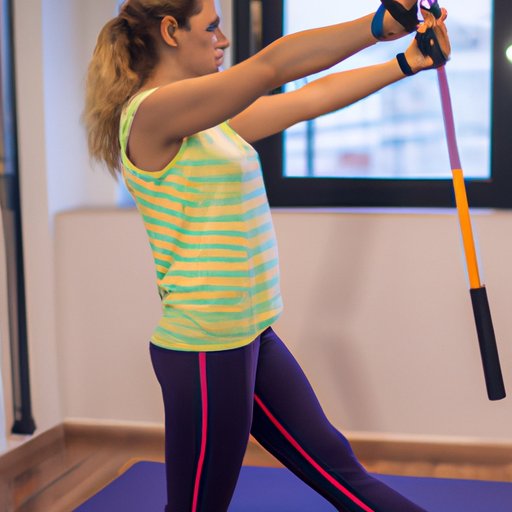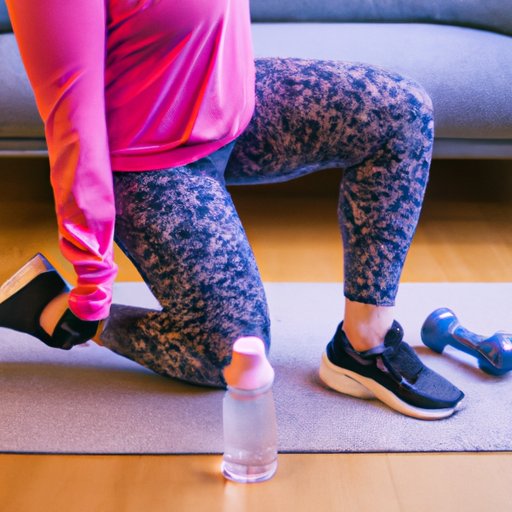Introduction
Exercise is an important part of staying healthy and maintaining a healthy lifestyle. It has many benefits, from improving cardiovascular health to increasing strength and flexibility. However, it’s important to choose the right exercises in order to get the most out of your workout. In this article, we’ll explore the different types of exercises and how they can benefit your health, as well as discuss exercises for specific goals and how to create an effective exercise routine.
Highlighting the Benefits of Different Exercises
Exercise can provide a variety of health benefits, including improved cardiovascular health, increased strength and flexibility, and improved balance and coordination. Let’s take a closer look at the benefits of different types of exercises.
Improved Cardiovascular Health
Cardiovascular exercises, such as running, biking, swimming, or walking, help to strengthen your heart and lungs. They also increase the efficiency of your body’s circulatory system, which helps to reduce the risk of heart disease and stroke. Regular aerobic exercise also helps to lower blood pressure, improve cholesterol levels, and reduce stress.
Improved Strength and Flexibility
Strength training exercises, such as lifting weights, using resistance bands, or bodyweight exercises, help to build muscle and improve overall strength. They also help to improve flexibility, balance, and coordination. Additionally, strength training helps to prevent osteoporosis by strengthening bones, reducing the risk of fractures.
Improved Balance and Coordination
Balance and coordination exercises, such as yoga, Pilates, and tai chi, help to improve your posture, reduce the risk of falls, and increase your agility. These exercises also help to relax your mind and improve your focus and concentration.

Exploring the Different Types of Exercises
There are three main types of exercises: aerobic, strength training, and stretching and flexibility exercises. Let’s take a closer look at each one.
Aerobic Exercise
Aerobic exercises, such as running, biking, swimming, or walking, are activities that require sustained physical effort and involve large muscle groups. These exercises help to increase your heart rate and breathing rate, which helps to improve your cardiovascular health. Aerobic exercises also help to burn calories and can aid in weight loss.
Strength Training
Strength training exercises, such as lifting weights, using resistance bands, or bodyweight exercises, involve lifting, pushing, or pulling weights in order to build muscle. These exercises help to increase strength, improve flexibility, and reduce the risk of injury. Additionally, strength training can help to improve bone density and reduce the risk of osteoporosis.
Stretching and Flexibility Exercises
Stretching and flexibility exercises, such as yoga, Pilates, and tai chi, help to improve your range of motion and flexibility. These exercises also help to relax your muscles, reduce the risk of injury, and improve balance and coordination. Additionally, stretching and flexibility exercises can help to reduce stress and improve your overall mental wellbeing.
Creating a Beginner’s Guide to Exercising
If you’re new to exercising, it’s important to understand your fitness level and set realistic goals. Here are some tips for creating a beginner’s guide to exercising:
Understanding Your Fitness Level
The first step in creating an exercise routine is to understand your current fitness level. Ask yourself questions about your current activity level, any health issues you may have, and how often you exercise. This will help you determine what type of exercises are best suited to your individual needs.
Setting Goals for Exercise
Once you’ve determined your fitness level, it’s time to set goals for exercise. Think about why you want to start exercising and what you want to achieve. Setting achievable goals will help to keep you motivated and on track.
Choosing the Right Exercises
Once you’ve set your goals, it’s time to choose the right exercises for you. Consider the types of exercises we discussed above and decide which ones are best suited to your needs. It’s also important to remember to mix up your workouts so that you don’t get bored.
Examining the Effects of Exercise on Health
Exercise has a wide range of positive effects on both physical and mental health. Let’s take a closer look at the effects of exercise on health:
Physical Health Benefits
Regular exercise can help to improve your physical health in a variety of ways. It can help to lower blood pressure, reduce the risk of heart disease and stroke, improve cholesterol levels, and reduce the risk of osteoporosis. Additionally, regular exercise can help to improve your overall energy levels and reduce fatigue.
Mental Health Benefits
Exercise also has positive effects on mental health. It can help to reduce stress, improve mood, and boost self-esteem. Exercise can also help to improve cognitive function, concentration, and memory. Additionally, it can help to reduce symptoms of depression and anxiety.

Discussing the Role of Exercise in Weight Loss
Exercise can play an important role in weight loss. Here are some ways exercise can help you lose weight:
Burning Calories
Exercise helps to burn calories, which can lead to weight loss. The more intense the exercise, the more calories you will burn. Additionally, regular exercise can help to boost your metabolism, which helps to burn calories even when you’re not actively exercising.
Building Muscle
Strength training exercises can help to build muscle, which can increase your metabolism and help you to burn more calories throughout the day. Additionally, building muscle can help to give your body a more toned and shapely appearance.
Increasing Metabolism
Exercise can help to boost your metabolism, which helps to burn calories even when you’re not actively exercising. Additionally, exercise can help to reduce fat and increase lean muscle mass, which can further increase your metabolism.
Exploring Exercises for Specific Goals
Different exercises can be used to achieve different goals. Here are some examples of exercises for specific goals:
Building Strength
Strength training exercises, such as lifting weights, using resistance bands, or bodyweight exercises, are ideal for building strength. Additionally, doing exercises that involve multiple muscle groups, such as squats or lunges, can help to build overall strength.
Increasing Endurance
Aerobic exercises, such as running, biking, swimming, or walking, are ideal for increasing endurance. These exercises help to increase your heart rate and breathing rate, which can help to improve your overall stamina and endurance.
Improving Flexibility
Stretching and flexibility exercises, such as yoga, Pilates, and tai chi, are ideal for improving flexibility. These exercises help to increase your range of motion and reduce the risk of injury.

Creating an Exercise Routine for Maximum Results
Creating an effective exercise routine is the key to getting the most out of your workouts. Here are some tips for creating an exercise routine for maximum results:
Developing a Schedule
It’s important to create a schedule that works with your lifestyle. Try to make a plan that allows you to exercise regularly, such as 3-4 times a week. Additionally, try to find time to exercise even on days when you’re busy or feeling tired.
Mixing Up Your Workouts
In order to stay motivated and avoid boredom, it’s important to mix up your workouts. Try to add variety to your routine by incorporating different types of exercises, such as strength training, aerobic exercise, and stretching and flexibility exercises.
Monitoring Your Progress
It’s important to monitor your progress in order to stay motivated and ensure that you’re meeting your goals. Keep track of your workouts and measure your progress over time. Additionally, celebrate your successes and reward yourself for reaching your goals.
Conclusion
Exercise has many benefits, from improving cardiovascular health to increasing strength and flexibility. There are a variety of different types of exercises, and it’s important to choose the right ones for your individual needs. Additionally, it’s important to create an effective exercise routine and monitor your progress in order to get the most out of your workouts. With these tips, you can start on the path to a healthier lifestyle.
(Note: Is this article not meeting your expectations? Do you have knowledge or insights to share? Unlock new opportunities and expand your reach by joining our authors team. Click Registration to join us and share your expertise with our readers.)
